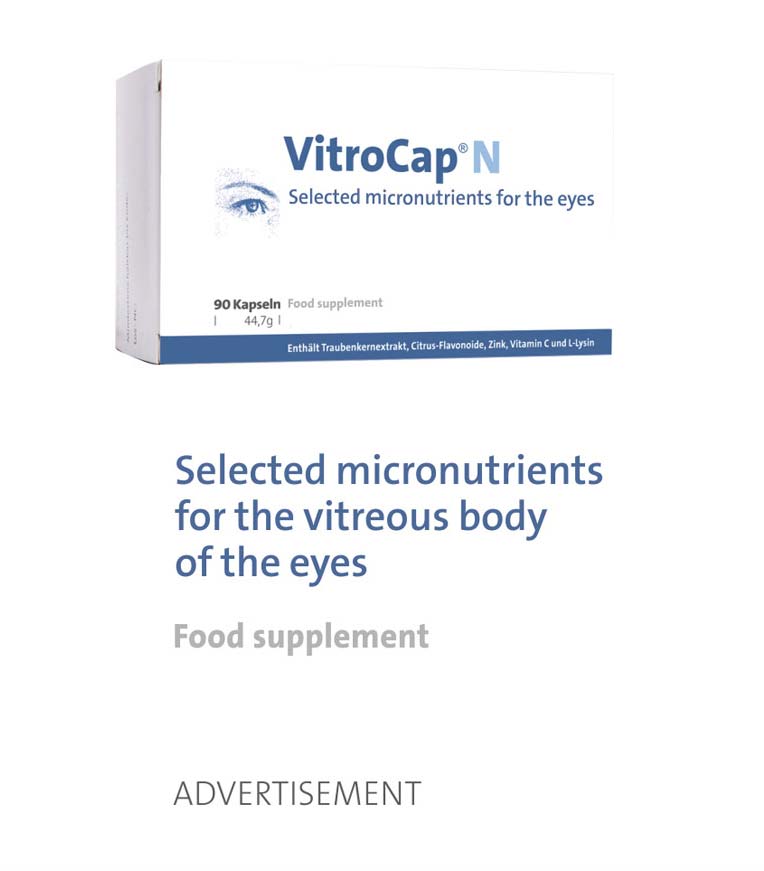Clinical Trials on Eye Floater Management
Has anyone ever cured Floaters?
Since 2013, significant scientific research has been conducted to evaluate the efficacy of supplementation with specific micronutrients in managing eye floaters. In five clinical trials European researchers demonstrated notable improvements in patients suffering from vitreous floaters when supplemented with VitroCap®N. This food supplement contains 5 mg of zinc, 40 mg of vitamin C, 26.3 mg Grape seed extract (25 mg of proanthocyanidins), 100 mg of Citrus fruit extract (60 mg of biflavonoids as Hesperidin) and 125 mg of L-lysine.

Clinical Trial 2024 & 2021, Waterford, Ireland: 6 months | placebo-controlled | double-blind | 61 patients
Title of publication: Dietary Intervention With a Targeted Micronutrient Formulation Reduces the Visual Discomfort Associated With Vitreous Degeneration
Research Team: Emmanuel Ankamah, Marina Green-Gomez, Warren Roche, Eugene Ng, Ulrich Welge-Lüßen, Thomas Kaercher, and John M. Nolan
Trial Overview: The FLIES study is the first to assess the impact of targeted nutritional supplementation on vitreous floaters, in the context of a randomized, double-blind, placebo-controlled clinical trial. The clinical trial included 61 patients, aged 18-79 years, who were supplemented with VitroCap®N. The evaluation was conducted using the following measures:
-
- Floater Disturbance Questionnaire: The research team utilized the Floater Disturbance Questionnaire, a short, disease-specific patient-reported outcome measure specifically designed to capture the subjective response of patients suffering from vitreous floaters as part of this study. The questionnaire comprised questions, which used response ratings, to assess the visual discomforts associated with floaters.
- Vitreous Opacity Area Quantification: Using the ultra-widefield imaging module of the SPECTRALIS HRA + OCT by Heidelberg Engineering GmbH, the research team captured a 30-second, 102° field, cross-polarized infrared reflectance movie of the vitreous. Patients were instructed to move their gaze in various directions, after each direction returning their gaze back to an internal fixation target. Five still images of eye floaters were extracted from the video, each captured from a different angle. Subsequently, vitreous opacity outlines were delineated manually using a ‘freehand selection’ tool. The areas of vitreous opacity from the five images were calculated individually and then combined, with the total reported in square centimeters.
- Visual Function Assessment: Visual Function Assessment: The research team evaluated visual function through various tests:
-
- Best Corrected Visual Acuity (BCVA) was measured using the computerized Test Chart 2000 Xpert, employing the LogMAR Early Treatment Diabetic Retinopathy Study test chart.
-
-
- Letter contrast sensitivity was assessed at five different spatial frequencies using the Test Chart 2000 PRO, a computerized test chart.
- Functional contrast sensitivity was evaluated using the Acuity-plus test from the Advanced Vision and Optometric Test.
- Cone and rod sensitivities were measured utilizing the Flicker-Plus test.
-
Results: The research was able to demonstrate significant improvements in both subjective visual disturbances and in objective parameters.
- The complaint score improved in 67% of the patients, and the subjective reduction of eye floaters was highly significant.
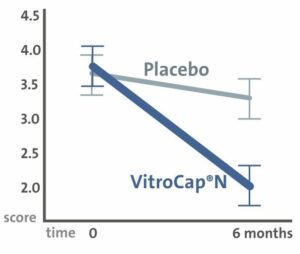
2. The vitreous opacity was reduced in 77% of the patients.

3. A significant improvement in visual function was observed concerning the contrast sensitivity.
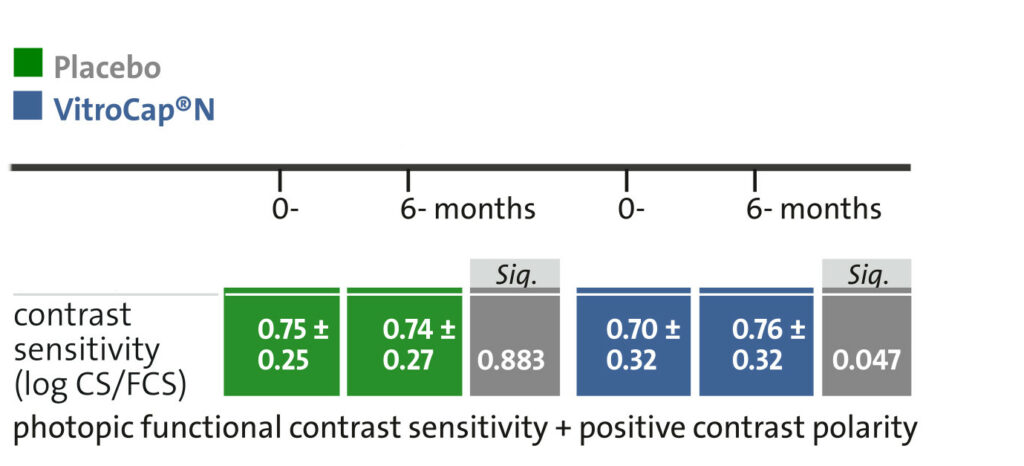
The observed benefit in the active group confirms that dietary intake of a formulation of antioxidative and antiglycative micronutrients could mitigate the mechanisms underlying vitreous degeneration, thereby decreasing the visual discomfort associated with vitreous floaters.
2024 update: Warren Roche, PhD, lead statistician of the FLIES study, will leverage his statistical expertise to delve deeper into the original findings and explore their clinical implications within this new study. More information to be found here: https://www.opticianonline.net/content/news/vivaquity-and-ebiga-vision-launch-new-floater-study
Clinical Trial 2019, St. Petersburg, Russia: 3 months | case control study | 32 patients
Title of publication: Efficacy of “Vitrocap” in patients with vitreous degeneration
Research team: Т.S. Varganova, А.G. Veryasova and Е.D. Erysheva
Trial overview: The main aim of the trial was to evaluate the clinical efficacy of nutritional supplementation in patients with vitreous degeneration. Additionally, the psychological characteristics of individuals complaining of ‘floaters’ were analyzed. The clinical trial was conducted with 32 patients aged 37-57 years, all of whom had vitreous floaters confirmed by ocular ultrasonography. Patients were divided into two groups: 16 who were supplemented with VitroCap® for 3 months (main group) and 16 who received a placebo (control group). The evaluation was carried out using the following measures:
-
- Floater Disturbance Questionnaire: The research team developed a scale to reflect the impact of this complaint on visual comfort, ranging from one to four, as follows:
- 1 – discomfort (“cannot work, need a sick leave”)
- 2 – “I see floaters every day, they disturb active visual work”
- 3 – “I notice floaters sometimes”
- 4 – “I don’t see any floaters”
- Standard Ocular Ultrasonography: Patients underwent eye scans using the Tomey UD-800 device before and after treatment. This scan looked at the inside of the eye using sound waves. The settings were adjusted for each patient and stayed the same for follow-up scans. Opacity location and density were checked, and their features were recorded.
- Minnesota Multiphasic Personality Inventory (MMPI): A test was used to understand how patients react emotionally to visual discomfort. It included questions about personality traits like worrying too much or feeling overly emotional. The honesty of answers was also checked.
- Floater Disturbance Questionnaire: The research team developed a scale to reflect the impact of this complaint on visual comfort, ranging from one to four, as follows:
Results: The research was able to demonstrate significant improvements in subjective visual disturbances (Questionnaire) and in the objective parameters (standard ocular ultrasonography) after treatment with VitroCap®.
- The complaint score improved in 76% of the patients.

©Т.S. Varganova, А.G. Veryasova and Е.D. Erysheva - A reduction in the number of opacities was observed on the B-scan in 32% of patients, corresponding to the decreased number of echogenic spikes on A-scans. Additionally, an improvement in the characteristics of vitreous opacities, such as the amplitude of ultrasound spikes, was observed in 80% of cases.

Before (left) and after (right) a course of VitroCap®. Patient P.: B-scan: transverse projection along the meridian to 6 hours, moderate amount of “clouding” in the vitreous body. A-scan before using VitroCap®N :21 peaks low amplitude spikes. After 3 months of VitroCap®N: 12 low amplitude spikes. ©Т.S. Varganova, А.G. Veryasova and Е.D. Erysheva
The observations confirmed that VitroCap® supplement improves visual comfort and, in most cases, reduces patients’ subjective complaints of floaters. Additionally, it was demonstrated that after treatment with VitroCap®, there was a tendency for a reduction in vitreous opacities and changes in their qualitative characteristics.
Observational Trial 2018, Warsaw, Poland: 3 months | 463 patients
Title of publication: The Effect of oral Supplementation with L-lysine, Hesperidin, Proanthocyanidins, Vitamin C and Zinc on Subjects’ Assessment of the Quality of Vision in Patients with Vitreous Floaters
Research team: Maria Sobol, Maciej Osęka, Thomas Kaercher and Bettina Schmiedchen
Trial overview: The observational trial was performed with 463 patients, aged 15-61 years. Their visual floaters symptoms were verified before treatment: 90% of the patients reported visual disturbances. They were mild in 27%, moderate in 28%, highly disturbing in 28% and extremely disturbing in 7% at baseline. For the analysis, the patients were divided according to their gender, and within each sex in addition to the age ranges of 20-30, 30-40, 40-50, 50-60, 60-70, 70-80 and 80 respectively. Evaluation was conducted before and after 3 months of treatment with the VitroCap®N-formulation using the following measures:
- Floater Disturbance Questionnaire: The research team developed a questionnaire to access the intensity of visual disturbance as well as the kind of situations in which patients suffer from floaters.
- Visual disturbance:
- 0 – non
- 1 – small
- 2 – mild
- 3 – highly disturbing
- 4 – extremely disturbing
- Disturbing situations:
- 0 – non such
- 1 – driving car
- 2 – reading
- 3 – other unclassified life situations
- Visual disturbance:
Results: The research was able to demonstrate significant improvements in subjective visual disturbances and disturbing situations.
- Visual disturbance: Before treatment, 90% of the patients reported visual disturbances, categorized as mild in 27%, moderate in 28%, highly disturbing in 28%, and extremely disturbing in 7% at baseline. The supplementation resulted in a notable alleviation of floater disorders, with greater improvements in vision observed in younger patients (<50 years), while no differences were observed between sexes. After treatment with the VitroCap®N-formulation, 64.7% of patients reported a moderate, significant, or very substantial improvement in visual disturbances.
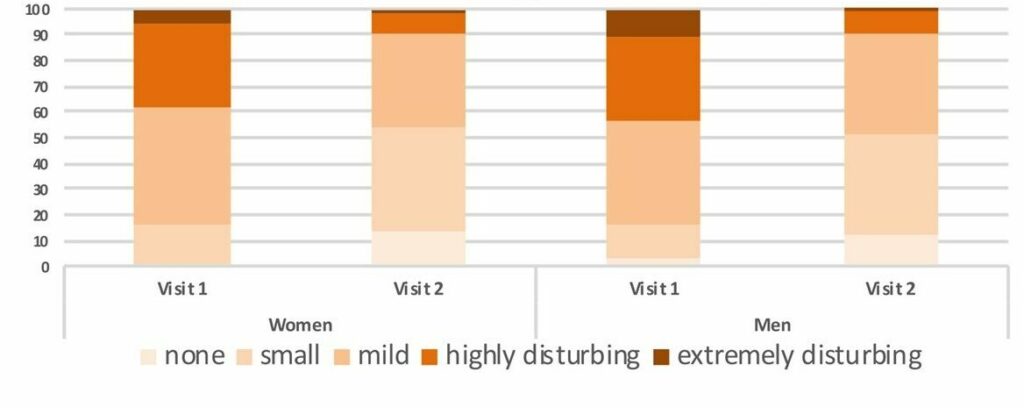
©Maria Sobol, Maciej Osęka, Thomas Kaercher and Bettina Schmiedchen - Disturbing situations: After supplementation the percentage of patients who would report “no such situations” increased significantly.

©Maria Sobol, Maciej Osęka, Thomas Kaercher and Bettina Schmiedchen
Clinical Trial 2015, Minsk, Belarus: 3 months | case control study | 62 patients
Title of publication: Experience of VitroCap® use in vitreous degeneration
Research Team: L.N. Marchenko, A.A. Dalidovich, T.V. Kachan, I.G. Gudievskaya, N.V. Nikitina and M.G. Lonskaya
Trial Overview: The clinical trial involved 62 patients aged 40-64 years to assess the efficacy of VitroCap® in treating vitreous degeneration. Confirmation of vitreous floaters was achieved via ocular ultrasonography. Patients were divided into two groups: the treatment group (Group I) comprised 29 patients (58 eyes) who received one capsule of VitroCap® daily with a meal, while the control group (Group II) comprised 33 patients (66 eyes) who did not receive any treatment for vitreous degeneration. Both groups were similar in terms of age and medical parameters. Evaluation was conducted three months post-treatment.
- Floater Disturbance Questionnaire: The research team developed a scale questionnaire to access the effect of the treatment: How did the condition of each of your eyes change 3 months after commencement of treatment?”
- better/better (b/b),
- better/no change (b/no ch.),
- better/worse (b/w)
- no change/no change (no ch.)
- worse/no change (w/no ch.)
- worse/worse (w/w)
- Vitreous Body Assessment: The research team evaluated the degeneration of the vitreous using B-mode ultrasonography, Split-lamp and OCT.
- Visual Function Assessment: The research team evaluated visual function through visual acuity measurement and autorefraction test.
Results: After the administration of VitroCap®, 65.5% of patients reported an improvement in vision quality. In contrast, the control group exhibited a 12.4% improvement over the three-month period. Changes observed in slit-lamp examination and B-mode vitreous ultrasonography results were comparable between both groups. Additionally, no significant changes were detected in the function of the visual system.
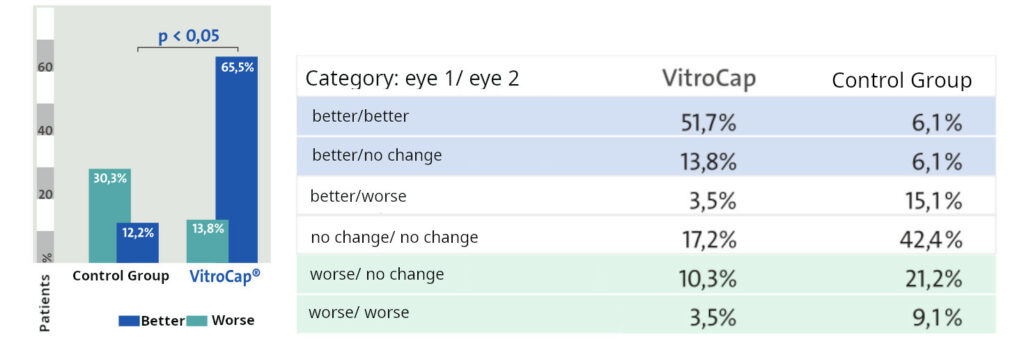
Clinical Trial: 2013 -, Heidelberg, Germany: 3 months | observational study | 24 patients
Title of publication: With dietary means against an annoying visual disturbance -Observation of application results in symptom improvement Mouches volantes after nutritional influence on the vitreous metabolism
DOWNLOAD POSTER TRIALS 2013 & 14
DOWNLOAD ARTICLE IN JOURNAL OF PRACTICAL OPHTALMOLOGY & OPHTAMOLOGICAL EDUCATION
Research Team: Dr. Th. Kaercher
Trial Overview: 24 patients participated in the observation, ranging in age from 21 to 81 years. Vitreous body floaters were confirmed using slit lamps. More than 80% of the participants reported noticing disturbances in their field of vision. All patients were treated with VitroCap® for 3 months. Subjective floater disturbance before and after Treatment was assessed using:
- Floater Disturbance Questionnaire: This questionnaire was developed to access the intensity of floater disturbance as well as the time of the day and special activities when patients suffer from floaters.
- Visual disturbance:
- 1 (poor) to 5 (extremely)
- Time of the day:
- in the moring
- in the evening
- Activities:
- reading
- driving car
- getting up after lying or sitting
- other situations
- Visual disturbance:
Results: The number of disturbing floater effects after intake was reduced in the morning, in the evening and while reading. Improved after the supplementation with VitroCap® was affirmed by 87,5% of patients. Overall visual disturbance scar decreased from 3,63 to 1,33.

